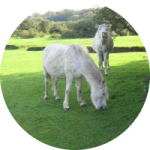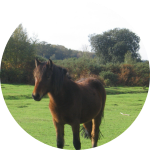| Home |
Welcome to the Horse Stall |
|
Horse Stall contains all types of information for Horse Lovers.
There are a number of products branded horse gifts and products.
Horse Articles :: Percheron Horse
|
Percheron Horse
|
|
The Percheron is a very ancient breed of French draft horse that many people are familiar with, though perhaps not by name. These gigantic horses can't help but be noticed, and are often used for novelty carriage rides, and there's usually a few in harness at state and county fairs. They have also appeared in advertisements and company logos in the United States many times. The breed derives its name from the Perche Valley of the Le Perche province in northwest France, 50 miles southwest of Paris; a region long famed for its horses. From the earliest known times the people of Le Perche have been producers of horses, but not often buyers of them, so in terms of breeding stock, they are an isolated equine population. However, the mysterious origins of the Percheron have been lost over time because the breed pre dates documented pedigrees and organized breeding in Europe by several centuries. Some believe the Percheron descends from the original horses that were found in France during the Ice Age. Others say that the breed is closely related to the French Boulonnais draft horses that were used in the Roman invasion of Brittany. Another theory is that the breed is from Abd el Rahman's Arab stallions or from some of the horses that were used by the invading Moors during the battle of Poitiers that were eventually divided among the victorious French forces. What is known is that twice in the history of the breed, native mares of the Le Perche region were mated with Arab stallions first during the 8th century and later during the Middle Ages, when historical records show that Percherons were used as military horses. By the time of the crusades, the Percheron was widely recognized as outstanding for size and soundness, as well as for beauty and style. By the 17th century, these horses produced in Le Perche had a widespread reputation that put them in demand for a number of heavy duty uses. After the invention of gunpowder, heavy warhorses were no longer needed. The Percheron then became the choice for pulling heavy French stagecoaches called diligences and became known as diligence horses. With the invention of the railroad, Percherons switched from stagecoach driving to farm duty and other heavy labor. In the early 19th century, the government in France established a stud at Le Pin for developing mounts for the French army. In 1823, a horse named Jean Le Blanc was foaled in Le Perche and all of today's modern Percheron bloodlines trace directly to this stallion. Percherons were first imported to the United States in 1839 with thousands more imported during the last half of the 19th century. The Percheron is especially well suited to the U.S. because it can handle a wide variety of weather conditions and it quickly became the most popular horse of both the American farmer and the teamster who moved freight and cargo on the nation's streets. The Percheron was such a popular horse that by 1930, the census showed that there were three times as many registered Percherons as the other draft breeds, Shire, Belgian, and Clydesdale, combined. When horses were replaced by cars, this led to a decline in demand for draft horses and then following World War II, this ancient horse was almost lost when the invention of the modern farm tractor nearly made the breed extinct. The low point came in 1954 when just 85 head were recorded. Fortunately the Percheron was rescued by a handful of farmers, including many Amish; along with fans abroad and in France; all of whom were dedicated to the preservation of the breed and managed to keep it alive through the next twenty years of the draft horse depression. The 1960's saw a resurgence in the draft horse business as Americans rediscovered its usefulness. Percherons are now back on small farms and are also working in forests as logging animals that can take out a few trees without ruining the rest in the smaller woodlots. They can work on terrain where even the most modern tractors and four wheel drive vehicles fail and can work in mud and snow better than man made machines. Today, Percherons are used primarily as show horses, and they are sometimes seen pulling carriages for big city tourism and used for recreational driving such as hayrides, sleigh rides and parades, often in teams of dappled gray or black. They are still widely used for farm work in France and some parts of rural Europe. Old paintings and crude drawings from the Middle Ages traditionally show that the Percheron has been a breed of mostly gray horses. The French knight is almost always shown on a grey or white horse of considerable substance for that time. Nowadays, Percherons are generally black or gray, but there are also chestnut, sorrel, bay, roan, and other colors possible. Some registries only accept those black and gray, though chestnut, and bay are acceptable for registration in the US if accompanied by a DNA test confirming parentage. Some horses have white markings on the head and feet, but excessive white is undesirable. Like other draft horses, the Percheron has a very compact, muscular build which is designed to generate a lot of power. These horses have very heavily muscled hindquarters and short backs which is the best combination for power. They also have long, thick necks, and blocky heads with wide set full prominent eyes. The strong jaw and refined ears suggests Arabian ancestry. Their tails tend to be clipped for farm work, but when allowed to grow, they are long, wavy, and surprisingly silky. Stallions should have ruggedness about the head and mares should have a feminine look. Lately, modern show Percherons have been bred for a longer, thinner neck, a longer back, and longer, smoother looking muscles. However, these types of Percherons are used mainly as show horses and not for the really heavy work of their predecessors. They are shown in competition hitching and halter classes at many state and county fairs across the United States. Percherons can be ridden and some have even been trained into fine jumpers. Percherons range in height from 15 to 19 hands high, most are between 16 2 and 17 3 hands high. Weight ranges from an average of 1,900 pounds up to 2,600 pounds. One of the tallest horses recorded was a Percheron named Dr Le Gear, born in 1902, that was 21.1 hands high (7 feet) and weighed just over 3,000 pounds. In spite of their size, their life span is over 25 years. Just as with other draft horse breeds, the Percheron has a very pleasing disposition; gentle, amiable, friendly and curious around young children. The breed is proud, alert, intelligent, easily trained and willing to work. They will stand patiently without being tethered and can tolerate boring conditions and inexperienced handlers well. The Percheron is very versatile and adaptable breed. These horses also have incredible endurance, and they are remarkably agile and surefooted for a draft breed. Their imposing size demands the respect of all who view them. Yes, it is a high perch you are on if you are riding a Percheron. Author Resource:-> Crystal Eikanger is a writer for http://www.HorseClicks.com, classifieds of Percheron Horses for sale
|
Top Horses |
|
| Top Horse Movies | |
Horse Resources |
|
Horse Health |
|
Horse Breeds |
|
More Horses |
|


| Copyright 2005-2021 DR Management All rights reserved |
Dog Gifts | Wildlife Gifts | Handmade Horse Gifts |
